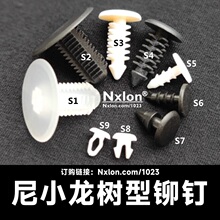Large Washers for Assemblies
©Nxlon.com D/T:

Large washers for assemblies are a commonly used part in mechanical assembly, and they usually have the following characteristics and applications:
Characteristics of Large Washers for Assemblies
Larger in size: Compared with ordinary washers, the diameter or other dimensional specifications of large washers for assemblies are larger, which can provide a larger supporting area.
Higher in strength: They are generally made of high-quality metal materials, such as carbon steel, stainless steel, etc., to withstand greater pressure and tensile force.
High precision requirements: The dimensional accuracy and geometric tolerances are controlled more strictly to ensure the matching accuracy with the assemblies.
Applications of Large Washers for Assemblies
Disperse pressure: Used at the connection parts, they can evenly disperse the pressure exerted by nuts or bolts to the surface of the connected parts, preventing the parts from being deformed or damaged due to excessive local pressure.
Increase sealing performance: In some assemblies that require sealing, large washers can fill the gaps between parts, enhance the sealing performance, and prevent the leakage of liquids or gases.
Adjust the clearance: By selecting large washers of different thicknesses, the clearance between the parts in the assembly can be adjusted to meet the requirements of assembly accuracy.
Protect the surface of parts: Avoid the direct contact between nuts or bolts and the surface of the connected parts during the tightening process, preventing the surface from being scratched or worn.
When selecting large washers for assemblies, it is necessary to choose suitable materials, sizes, and specifications according to specific usage requirements, such as working pressure, temperature, connection method, etc., to ensure the reliability and stability of the assemblies.
尼小龙塑料螺丝-塑料螺母-尼龙垫圈-塑料铆钉
内4.2外7.0黑色塑料直通柱隔离柱
订购链接:Nxlon.com/1015
内4.2外7.0塑料直通柱隔离柱是一种用于电子设备等领域的绝缘零部件,尼小龙现有直通柱M4系列内径=4.2mm;外径:M4系列外径都是7mm;高度:2到15mm
R3045-塑料铆钉-尼龙铆钉
订购链接:Nxlon.com/3045
R3045-塑料铆钉-尼龙铆钉塑料铆钉-尼龙铆钉-汽车塑胶铆钉-尼小龙尼龙铆钉R2.6R3.5R4R5塑胶柳钉子母铆钉快捷紧固件塑料卡扣。
R3550-塑料铆钉-尼龙铆钉
订购链接:Nxlon.com/3550
R3550-塑料铆钉-尼龙铆钉塑料铆钉-尼龙铆钉-汽车塑胶铆钉-尼小龙尼龙铆钉R2.6R3.5R4R5塑胶柳钉子母铆钉快捷紧固件塑料卡扣。
塑料芭蕾铆钉-尼龙宝塔卡扣
订购链接:Nxlon.com/1026
国标塑料铆钉芭蕾铆钉材质:POM、PC等;颜色:白色、黑色、透明;R型铆钉,芭蕾铆钉与宝塔铆钉起源于广东中山,它们都是一种简易铆接的塑料卡扣; 利用塑料的记忆性紧固两较薄的面板,铆定后可以再次取下,可重复使用。
绝缘透明塑料六角螺母
订购链接:Nxlon.com/1016
绝缘透明塑料六角螺母是一种采用聚碳酸酯(PC)材料制成的具有特定功能和特性的塑料螺母,尼小龙现有塑料螺母M3、M4、M5、M6、M8等公制规格。
塑料铆钉-尼小龙树形铆钉
订购链接:Nxlon.com/1023
绝缘塑料树形铆钉又称倒齿形塑料铆钉或圣诞树型塑料铆钉品名:树型塑料铆钉;材质:尼龙 Nylon;适合孔径:5.5mm-6.5mm;适合板厚:2.0mm-10.0mm









